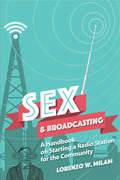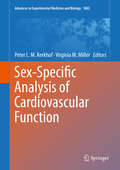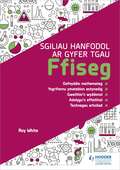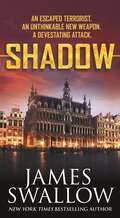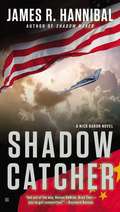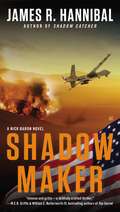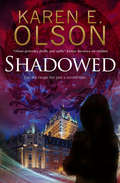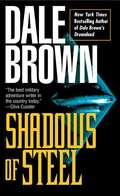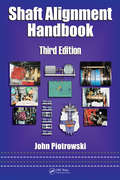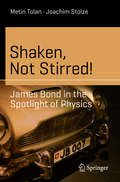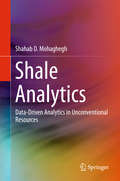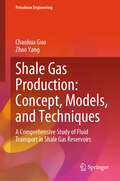- Table View
- List View
Sex and Broadcasting: A Handbook on Starting a Radio Station for the Community
by Lorenzo W. Milam Thomas J. Thomas"A goldmine ... wiser and funnier than almost any book in the field … the richest account yet published of the ways in which broadcasting is experienced, by both listener and broadcaster ... this is a wonderful book." ― The Times (London) Literary Supplement Nominally a guide to starting a home-grown, community radio station, this idiosyncratic book offers much more than that, including a passionate defense of noncommercial broadcasting. Lorenzo W. Milam, a pioneer in the development of listener-supported community radio, shares his enthusiasm and insights in a volume that has already inspired a generation of broadcasters and listeners and is poised to do the same for the podcasting generation. Although the details may change, the desire to communicate directly and honestly with a wider audience is a constant, and this impulse is fueled by Milam's splendidly eccentric handbook.
Sex and Relationships Education: A Step-by-Step Guide for Teachers (Spotlight Ser.)
by Simon BlakeThis book will enable and assist teachers responsible for organizing and delivering Sex and Relationships Education. It draws together the best available practice to support teachers in developing policy and classroom practice. It begins by looking at general principles and then focuses on primary, secondary and special schools as well as pupil referral units. These chapters will provide a toolkit of ideas and approaches that teachers can use in the classroom. Included are practical exercises that can be done alone or in staff meetings to prepare yourself or a colleague to deliver SRE, a glossary of terms that will support you in answering children's and young people's questions, advice on choosing, developing and using resources, and a list of useful organizations and websites. The book will be particularly helpful to PSHE coordinators, Health Promotion Units, National Healthy School Standard coordinators and SRE teachers in schools. LEA Advisors and Inspectors, and anyone involved in training and supporting teachers, will also find this a useful guide.
Sex, Tech, and Faith: Ethics for a Digital Age
by Kate OttA values-based, shame-free, pleasure-positive discussion of Christian ethics in response to a range of pressing issues in the digital age—including online pornography, dating apps, sexting, virtual-reality hookups, and sex robots.Digital innovation has rapidly changed the landscape of sexual experience in the twenty-first century. Rules-based sexual ethics, subscribed to by many Christians, are unable to keep up with new developments and, more often than not, seem effective at little other than generating shame.Progressive ethicist Kate Ott steps into this void with an expansive yet nuanced approach that prioritizes honesty and discernment over fear and judgment. Rather than producing a list of don&’ts, Ott considers the possibilities alongside the potential harm in everything from the use of internet porn to the practice of online dating to human-robot intimacy. With the aid of thought-provoking anecdotes and illuminating research, Ott invites readers to wrestle with the question of how to practice a just and flourishing sexuality in the digital age—and does so by drawing on core values of the Christian tradition.A rich resource for both individuals and groups, Sex, Tech, and Faith includes discussion questions at the end of each chapter for those considering these issues in community, as well as extensive youth study guides for parents, pastors, and teachers in need of age-appropriate means of beginning these difficult conversations with teens. Readers of all backgrounds and identities will be challenged to consider how their choices and habits in the digital world can lead to sexual health, wholeness, dignity, and fulfillment—for themselves and those in relationship with them.
Sex-Specific Analysis of Cardiovascular Function (Advances in Experimental Medicine and Biology #1065)
by Peter L. Kerkhof Virginia M. MillerThis book gathers together contributions from internationally renowned authors in the field of cardiovascular systems and provides crucial insight into the importance of sex- and gender-concepts during the analysis of patient data. This innovative title is the first to offer the elements necessary to consider sex-related properties in both clinical and basic studies regarding the heart and circulation on multiscale levels (i.e. molecular, cellular, electrophysiologically, neuroendocrine, immunoregulatory, organ, allometric, and modeling). Observed differences at (ultra)cellular and organ level are quantified, with focus on clinical relevance and implications for diagnosis and patient management. Since the cardiovascular system is of vital importance for all tissues, Sex-Specific Analysis of Cardiovascular Function is an essential source of information for clinicians, biologists, and biomedical investigators. The wide spectrum of differences described in this book will also act as an eye-opener and serve as a handbook for students, teachers, scientists and practitioners.
Seymour Simon's Book of Trains
by Seymour SimonTrains can carry, grain, gravel, milk, machines, cars, computers, pipes and people. Seymour Simon′s exploration of these very different trains and their uses, combined with his characteristically eye-catching. He captures the beauty and power of steam trains, diesel trains, electric trains, and more -- all at work.
Sgiliau Hanfodol ar gyfer TGAU Ffiseg (Essential Skills for GCSE Physics: Welsh-language edition)
by Roy WhiteThis book is the Welsh Language edition.Build essential maths, literacy and working scientifically skills to boost marks in GCSE Physics and ensure that students reach their full potential.Suitable for all specifications, this skills book provides additional support and will help to:- Sharpen mathematical skills with plenty of practice questions and coverage of all the maths techniques needed for the exams.- Improve literacy skills with tips on how to write longer answers, plus peer-assessment marking activities.- Develop the working scientifically skills needed to plan, carry out and evaluate practical experiments, in order to secure the maximum number of marks.- Build confidence by putting skills into practice; using our three-step formula students will progress from worked examples to guided questions and exam-style questions, with fully-worked solutions in the book.- Raise performance in the exams with practical advice on how to revise effectively and tips on understanding the questions, command words and assessment objectives.
Sgiliau Hanfodol ar gyfer TGAU Ffiseg (Essential Skills for GCSE Physics: Welsh-language edition)
by Roy WhiteThis book is the Welsh Language edition.Build essential maths, literacy and working scientifically skills to boost marks in GCSE Physics and ensure that students reach their full potential.Suitable for all specifications, this skills book provides additional support and will help to:- Sharpen mathematical skills with plenty of practice questions and coverage of all the maths techniques needed for the exams.- Improve literacy skills with tips on how to write longer answers, plus peer-assessment marking activities.- Develop the working scientifically skills needed to plan, carry out and evaluate practical experiments, in order to secure the maximum number of marks.- Build confidence by putting skills into practice; using our three-step formula students will progress from worked examples to guided questions and exam-style questions, with fully-worked solutions in the book.- Raise performance in the exams with practical advice on how to revise effectively and tips on understanding the questions, command words and assessment objectives.
Shadow (The Marc Dane Series #4)
by James SwallowNew York Times bestselling author James Swallow's The Marc Dane series continues with ShadowA ruthless far-right terrorist has broken out of captivity.A mysterious bio-scientist with a terrible secret is abducted.A lethal virus threatens millions of lives across Europe and the Middle East.Ex-MI6 officer Marc Dane and his partner, Lucy Keyes, are bound together in a desperate search for the sinister organization plotting the release of a deadly virus on the world. In their frantic race against time, Dane and Keyes will be tested more than ever before as they seem to find themselves one step behind at every turn. It will take everything they have to expose the evil forces lurking in the shadows and put a stop to this unstoppable pathogen … and even everything might not be enough.What price would you pay to stop a global catastrophe?At the Publisher's request, this title is being sold without Digital Rights Management Software (DRM) applied.
Shadow Catcher
by James R. HannibalFrom James R. Hannibal--a veteran combat pilot with Top Secret clearance from the U.S. government--comes an electrifying high-tech thriller in the great tradition of Tom Clancy... Over ten years ago, Air Force major Nick Baron was part of a failed special ops mission that left a B-2 stealth bomber at the bottom of the Persian Gulf. Now, leading his men--the Triple Seven Chase team--Baron must find the bomber and dispose of it for good before any unfriendly nation can steal the onboard technology for its own purposes. But as the team embarks on its mission, there are greater dangers waiting. When the CIA intercepts a call signal from an operative in China long thought dead, the Triple Seven Chase team is given the perilous task of retrieving the lone soldier from deep within the Chinese wilderness. There is only one plane for such a dangerous mission: the Shadow Catcher, a plane with capabilities beyond anything that has ever flown. What Baron and his men don't know is that the enemy is already among them--and that the Shadow Catcher itself may be the ultimate prize.
Shadow Family
by Miyuki Miyabe Juliet Winters CarpenterMurder mystery/police procedural set in Tokyo; dealing with interpersonal relationships on the internet and in the real world.
Shadow Flight (Steve Wickham #2)
by Joe WeberShadow Flight is a chilling international scenario of Soviet denial and American desperation. A U.S.B-2 Stealth bomber, Shadow 37, has disappeared while on a training mission. Its hijackers are unknown but its destination is Cuba. The salvation of U.S. technological secrets rests in the hands of CIA agent Steve Wickham. His mission: Recovery of Shadow 37.
Shadow Maker
by James R. HannibalHow far will collateral damage from a CIA drone strike reach? When a suicide bomber shatters the peace of a winter afternoon on the National Mall in Washington, D.C., former pilot and undercover Cerberus operative Nick Baron receives an eerie invitation from the chess app on his phone--a mysterious figure named The Emissary wants to play. Nick and his covert unit--the Triple Seven Chase team--soon find themselves drawn into battle against an unknown opponent who has resurrected an ancient order of assassins: the legendary Hashashin. And there is a long-awaited prophecy being fulfilled by a series of violent attacks which may culminate in a final apocalypse over Jerusalem. As the Triple Seven fight to stop each attack, Nick tries to keep The Emissary on the hook by playing their digital chess game. The lines between the game and the fight begin to blur, as every time Nick loses a piece on the board, he loses one of his men. And if Nick cannot find a way to stop the terrorist mastermind, a checkmate may kill millions...
Shadow State: The gripping new novel from the original SAS hero
by Andy McNabIn the dark world of cryptocurrency, there's a high price to pay...From the central bank of El Salvador to a tantalum mine in Rwanda, the Acropolis Museum in Athens to the biggest freeport on the planet in Dubai, enter a world ruled by ones and zeroes and inhabited by people who don't believe in trust.Nathan Pike is one of those people. To some he's a digital Robin Hood. To others he's nothing but an amoral hacker. A codebreaking and encryption expert, he sells his skills to whoever can pay him what he wants or give him something he needs.And when he's sprung from a Cambodian prison by a woman calling herself Melody Jones, he's made an offer the likes of which he's never seen before.MORE PRAISE FOR ANDY MCNAB:'A tremendous adventure story' – Daily Telegraph'Extraordinary' – The Times'A rollercoaster ride' – Guardian'Full on, fast-paced, gripping' – Sunday Sport'Authentic to the core' – Daily Express'Stunning' – Sun'Unstoppable' – Daily Mirror
Shadow State: The gripping new novel from the original SAS hero
by Andy McNabIn the dark world of cryptocurrency, there's a high price to pay...From the central bank of El Salvador to a tantalum mine in Rwanda, the Acropolis Museum in Athens to the biggest freeport on the planet in Dubai, enter a world ruled by ones and zeroes and inhabited by people who don't believe in trust.Nathan Pike is one of those people. To some he's a digital Robin Hood. To others he's nothing but an amoral hacker. A codebreaking and encryption expert, he sells his skills to whoever can pay him what he wants or give him something he needs.And when he's sprung from a Cambodian prison by a woman calling herself Melody Jones, he's made an offer the likes of which he's never seen before.MORE PRAISE FOR ANDY MCNAB:'A tremendous adventure story' – Daily Telegraph'Extraordinary' – The Times'A rollercoaster ride' – Guardian'Full on, fast-paced, gripping' – Sunday Sport'Authentic to the core' – Daily Express'Stunning' – Sun'Unstoppable' – Daily Mirror
Shadow State: The gripping new novel from the original SAS hero
by Andy McNab'Terrific' Sunday Times ___________In the dark world of cryptocurrency, there's a high price to pay . . .From the central bank of El Salvador to a tantalum mine in Rwanda, the Acropolis Museum in Athens to the biggest freeport on the planet in Dubai, enter a world ruled by ones and zeroes and inhabited by people who don't believe in trust.Nathan Pike is one of those people. To some he's a digital Robin Hood. To others he's nothing but an amoral hacker. A codebreaking and encryption expert, he sells his skills to whoever can pay him what he wants or give him something he needs.And when he's sprung from a Cambodian prison by a woman calling herself Melody Jones, he's made an offer the likes of which he's never seen before.MORE PRAISE FOR ANDY MCNAB:'A tremendous adventure story' – Daily Telegraph 'Extraordinary' – The Times 'A rollercoaster ride' – Guardian 'Full on, fast-paced, gripping' – Sunday Sport 'Authentic to the core' – Daily Express 'Stunning' – Sun 'Unstoppable' – Daily Mirror
Shadow of a Hero
by Peter DickinsonTo save a country, a girl and her grandfather must learn what it means to be a hero The greatest hero in the history of Varina was baptized in a cave. Every schoolchild knows the story. His parents were on their way to the city when a storm drove them to take shelter in the mountainside, along with a priest, a bandit, and a scholar. When the storm did not abate, they asked the priest to give their child a name, and he christened the boy Restaur Vax. The boy would grow to be a warrior, a scholar, and a man of god, and his name would lead an oppressed people to independence for the first time. Alas, that liberty would not survive. Generations later, Vax's oldest living descendant is in London, teaching the language of Varina to his inquisitive young granddaughter. When his homeland is torn apart once more by war, calls come for this man to take up the mantle of the Vax name--and become a hero for a new age. This ebook features an illustrated personal history of Peter Dickinson including rare images from the author's collection.
Shadow of a Hero
by Peter DickinsonTo save a country, a girl and her grandfather must learn what it means to be a hero The greatest hero in the history of Varina was baptized in a cave. Every schoolchild knows the story. His parents were on their way to the city when a storm drove them to take shelter in the mountainside, along with a priest, a bandit, and a scholar. When the storm did not abate, they asked the priest to give their child a name, and he christened the boy Restaur Vax. The boy would grow to be a warrior, a scholar, and a man of god, and his name would lead an oppressed people to independence for the first time. Alas, that liberty would not survive. Generations later, Vax's oldest living descendant is in London, teaching the language of Varina to his inquisitive young granddaughter. When his homeland is torn apart once more by war, calls come for this man to take up the mantle of the Vax name--and become a hero for a new age. This ebook features an illustrated personal history of Peter Dickinson including rare images from the author's collection.
Shadowed (The Black Hat Thrillers #2)
by Karen E. OlsonAn ex-cyberthief is on the run from her past in an &“electrifying&” thriller by the author of Hidden: &“an addictive page-turner with a stunner of a finale&” (Kirkus Reviews). For fifteen years, her name was Nicole Jones. Then her criminal past caught up to her. Now the brilliant computer hacker has reinvented herself once again, living as Susan McQueen on a remote island in Quebec, Canada. Susan lives a quiet life, but she hasn&’t given up her computer. While in an online chatroom, she discovers she has a shadow. Someone&’s hacked into her laptop—someone who knows who she is. Capable of watching her every move, they want a hefty payment in bitcoin not to make trouble. Now Susan is on the run again. But from whom? Is it the FBI or someone associated with her criminal past? Making her way across the border and back to America won&’t be easy. And as her shadow looms closer, Susan discovers just who—and what—she&’s up against.
Shadows of Steel (Patrick McLanahan Series #5)
by Dale BrownDeath, destruction, and military initials once again fill the air as Dale Brown brings together the surviving members of the crew from his Flight of the Old Dog for his latest adventure. Another Gulf War has begun, this time with Iran, a U.S. vessel has been sunk in the Persian Gulf, America's might has been (once again) crippled by short-sighted military budget cuts, and the only hope is a surgical strike by a secret weapon called Future Flight. Since our old pal Col. Patrick McLanahan of the Old Dog is in charge, how can it miss? As Brown points out, this story takes place in time between his Day of the Cheetah and Hammerheads.
Shady Practices: Agroforestry and Gender Politics in the Gambia
by Richard A. SchroederShady Practices is a revealing analysis of the gendered political ecology brought about by conflicting local interests and changing developmental initiatives in a West African village.
Shaft Alignment Handbook (Mechanical Engineering)
by John PiotrowskiRotating machinery is the heart of many industrial operations, but many engineers and technicians perform shaft alignment by guesswork or with limited knowledge of the tools and methods available to accurately and effectively align their machinery. Two decades ago, John Piotrowski conferred upon the field an unprecedented tool: the first edition of
Shaken, Not Stirred!: James Bond in the Spotlight of Physics (Science and Fiction)
by Joachim Stolze Metin TolanHow do James Bond’s X-ray glasses work, the ones he uses to see whether the lady at the roulette table has a pistol concealed in her underwear? Is it really possible to launch oneself into the air and catch up with a plane that is free-falling towards the earth? Or to shoot down a helicopter with a pistol? In this lively and informative book, Germany's boldest physics professor Metin Tolan analyses the stunts and gadgets of the 007 films and even answers the question of all questions: Why does Bond drink his vodka martini shaken, not stirred? "So much entertaining science is a rare thing." Spiegel Online
Shaking the Foundations of Geo-engineering Education
by Bryan McCabe Marina Pantazidou Declan PhillipsThis book comprises the proceedings of the international conference Shaking the Foundations of Geo-engineering Education (NUI Galway, Ireland, 4-6 July 2012), a major initiative of the International Society of Soil Mechanics and Geotechnical Engineering (ISSMGE) Technical Committee (TC306) on Geo-engineering Education. SFGE 2012 has been carefully
Shale Analytics
by Shahab D. MohagheghThis book describes the application of modern information technology to reservoir modeling and well management in shale. While covering Shale Analytics, it focuses on reservoir modeling and production management of shale plays, since conventional reservoir and production modeling techniques do not perform well in this environment. Topics covered include tools for analysis, predictive modeling and optimization of production from shale in the presence of massive multi-cluster, multi-stage hydraulic fractures. Given the fact that the physics of storage and fluid flow in shale are not well-understood and well-defined, Shale Analytics avoids making simplifying assumptions and concentrates on facts (Hard Data - Field Measurements) to reach conclusions. Also discussed are important insights into understanding completion practices and re-frac candidate selection and design. The flexibility and power of the technique is demonstrated in numerous real-world situations.
Shale Gas Production: A Comprehensive Study of Fluid Transport in Shale Gas Reservoirs (Petroleum Engineering)
by Zhao Yang Chaohua GuoThis book is a comprehensive overview of shale gas science and engineering, covering key facets such as the geological and geochemical characteristics of shale gas reservoirs, gas transport mechanisms in shale nanopores, mathematical models and case studies for gas production, and enhancing gas recovery methods. The author presents a systematic summarization of gas flow and production in shale gas reservoirs from micropore to macro-reservoir scale. The research methods encompass experiments, well-testing, numerical simulation, and mathematical derivation. Designed primarily as a reference work for petroleum industry practitioners and researchers, this book is equally valuable for new entrants and seasoned professionals. It is also an excellent resource for undergraduate and postgraduate courses and of interest to libraries at universities offering gas, oil, and general energy courses. Whether you're seeking an introduction to the field or a detailed exploration of advanced concepts, this book provides a valuable and complete guide to shale gas science and engineering.
